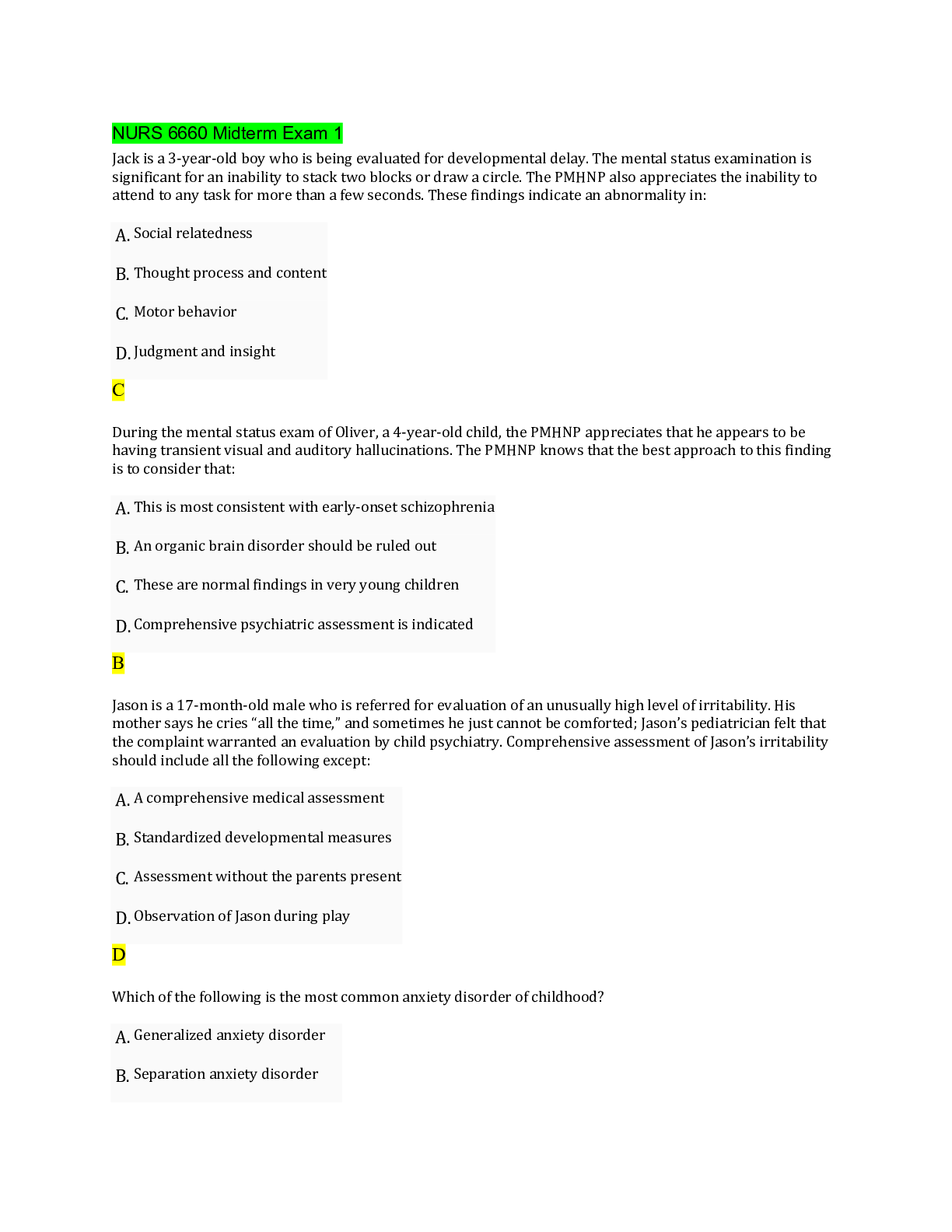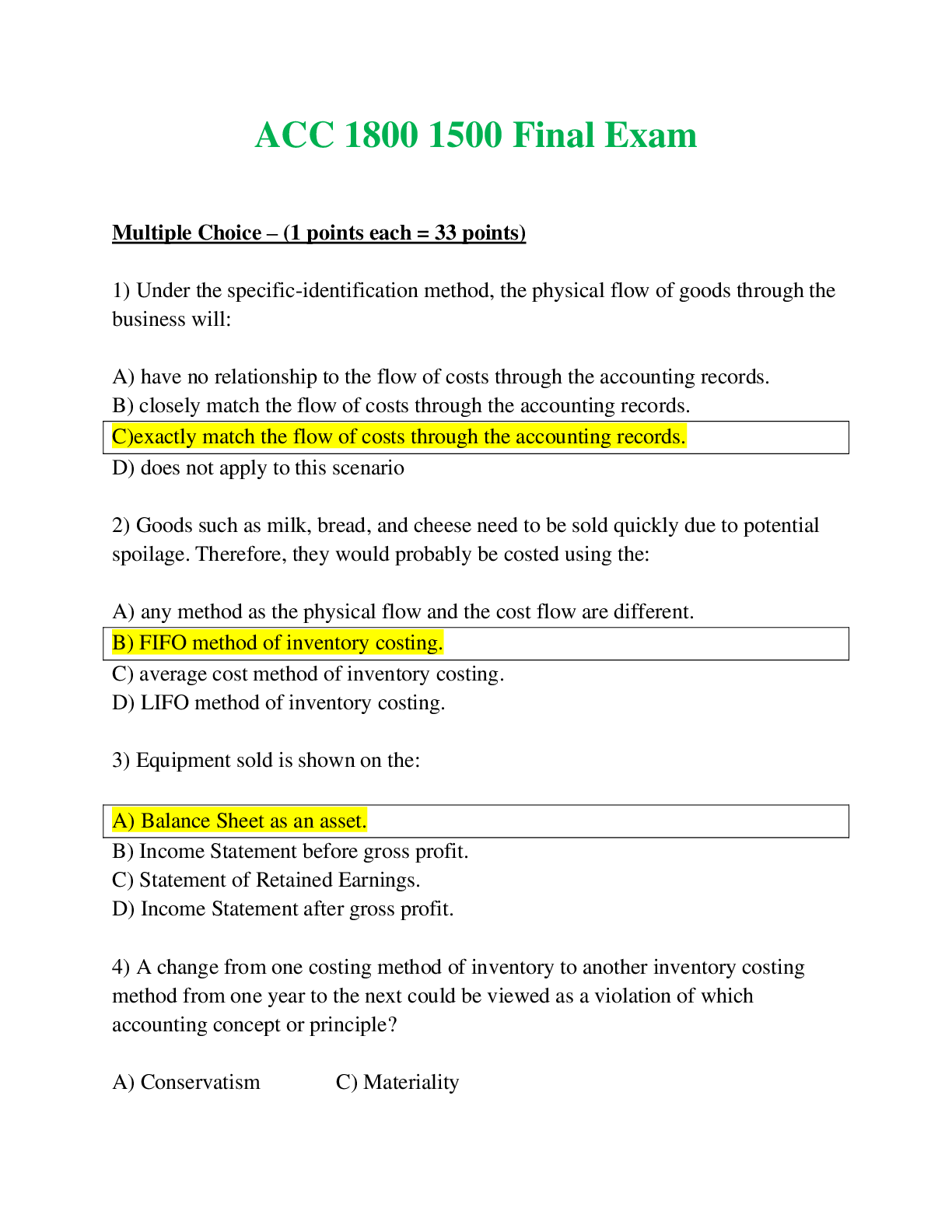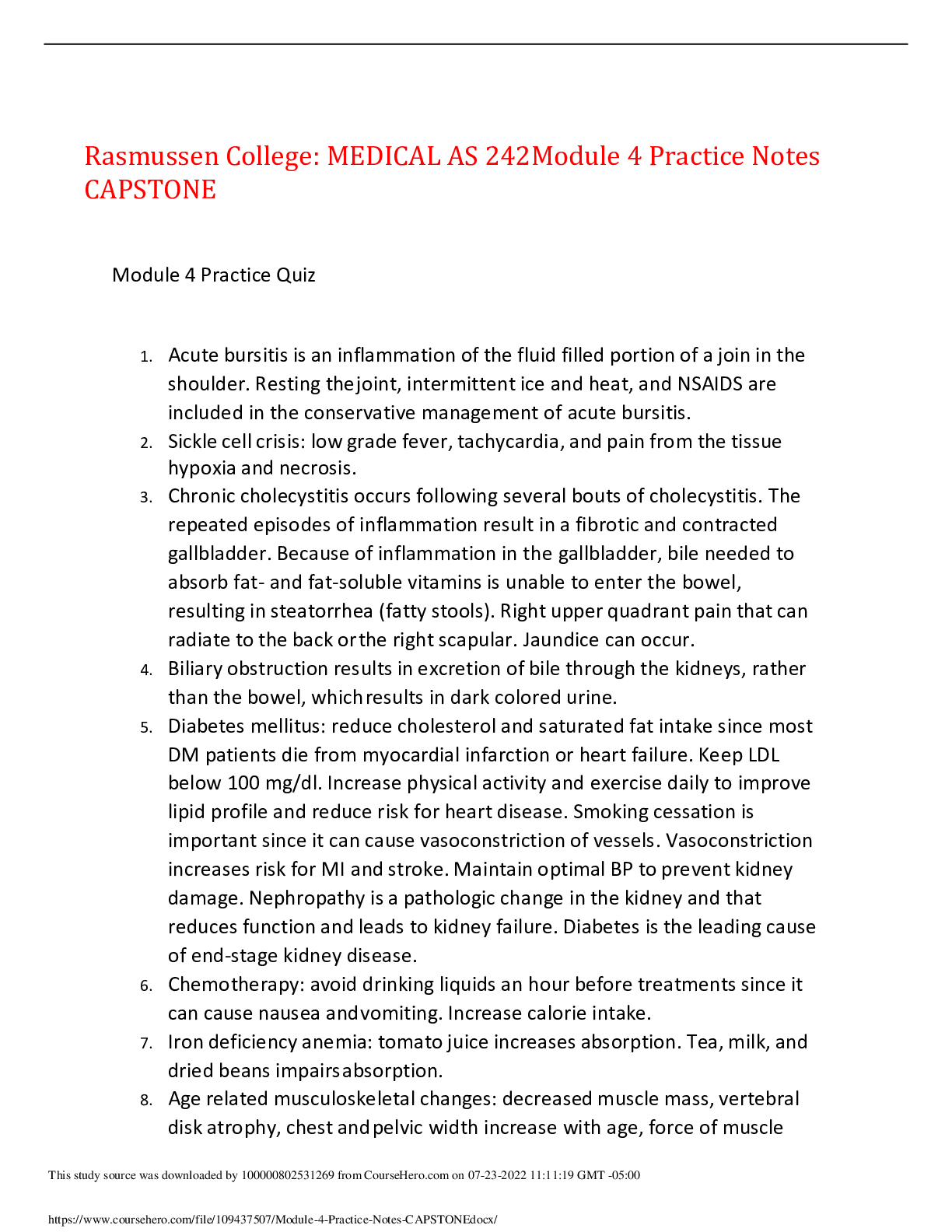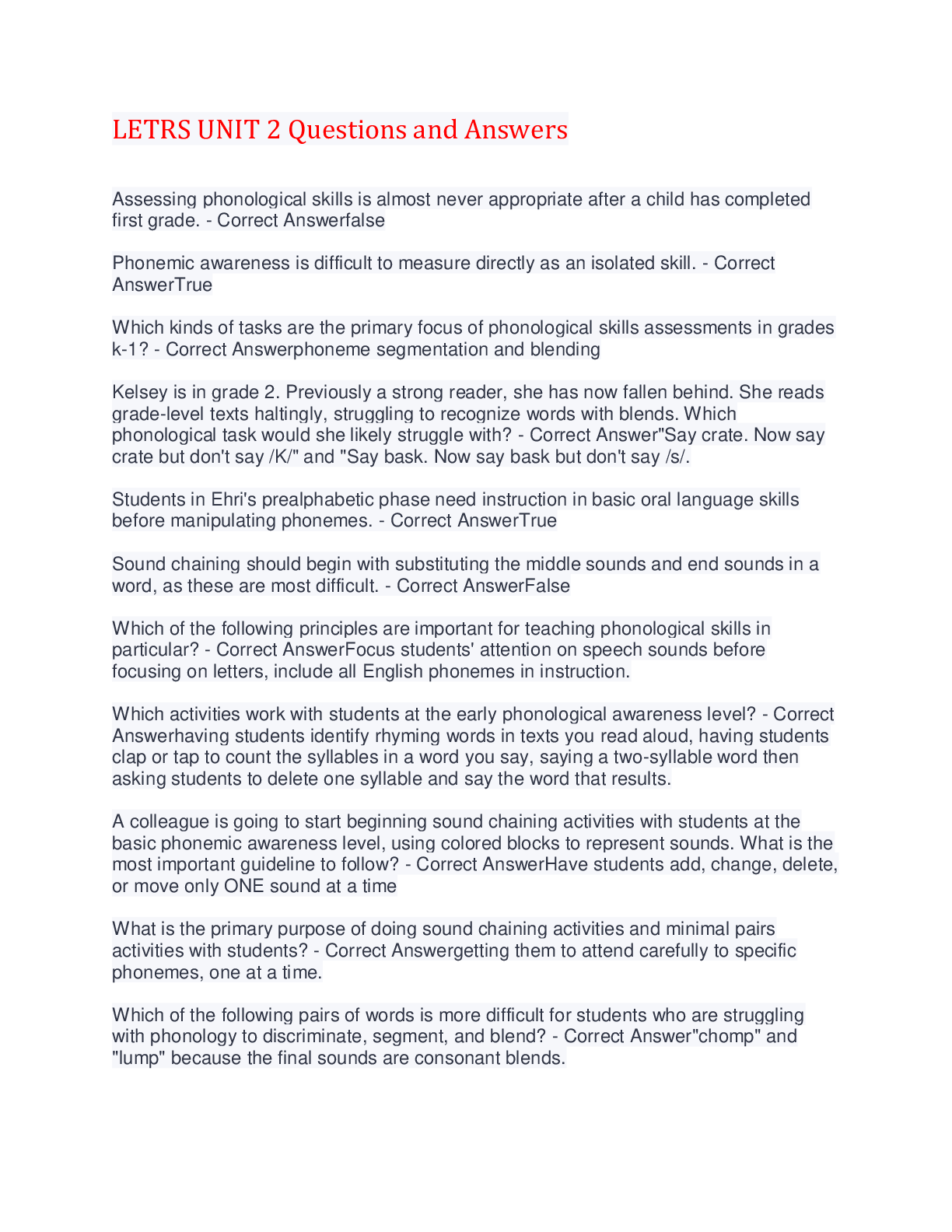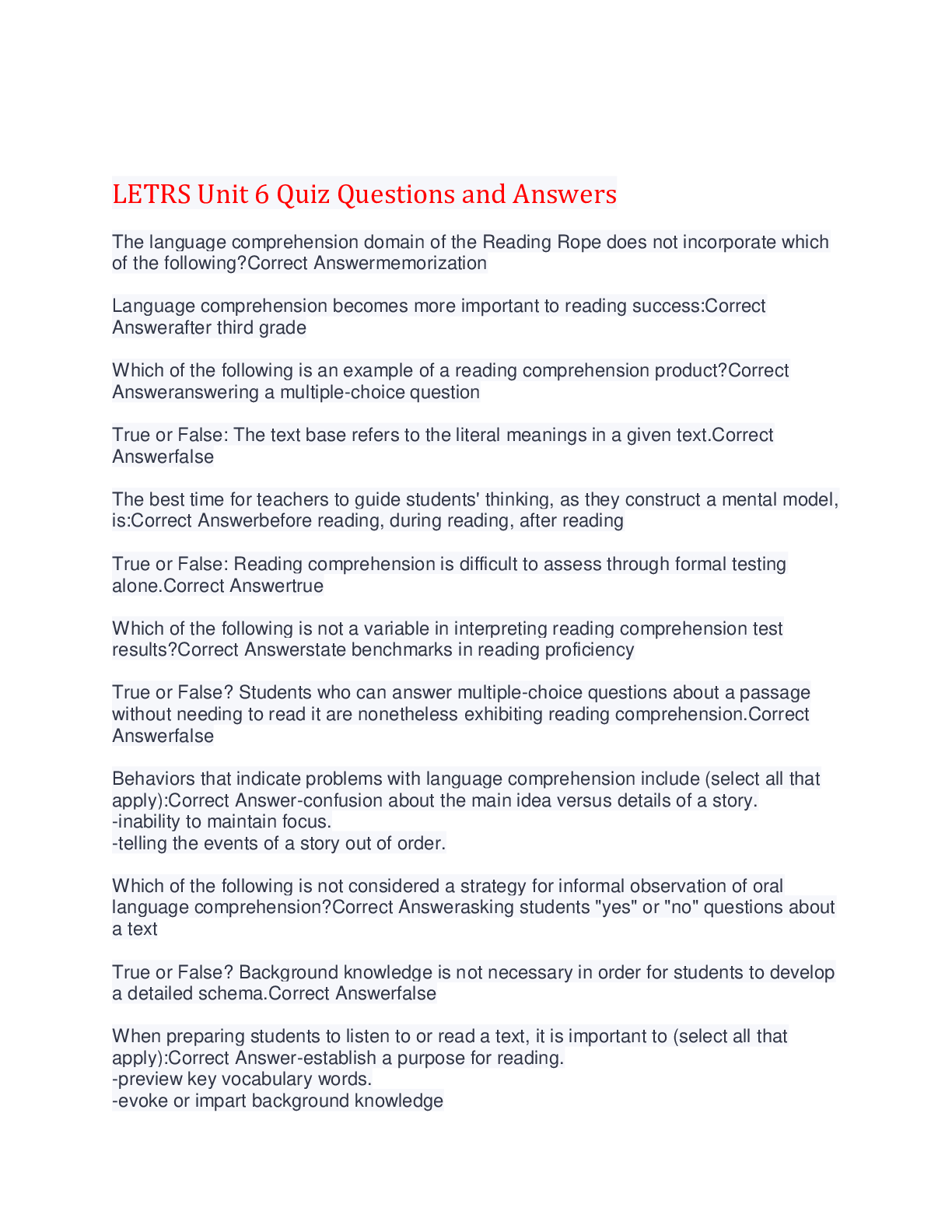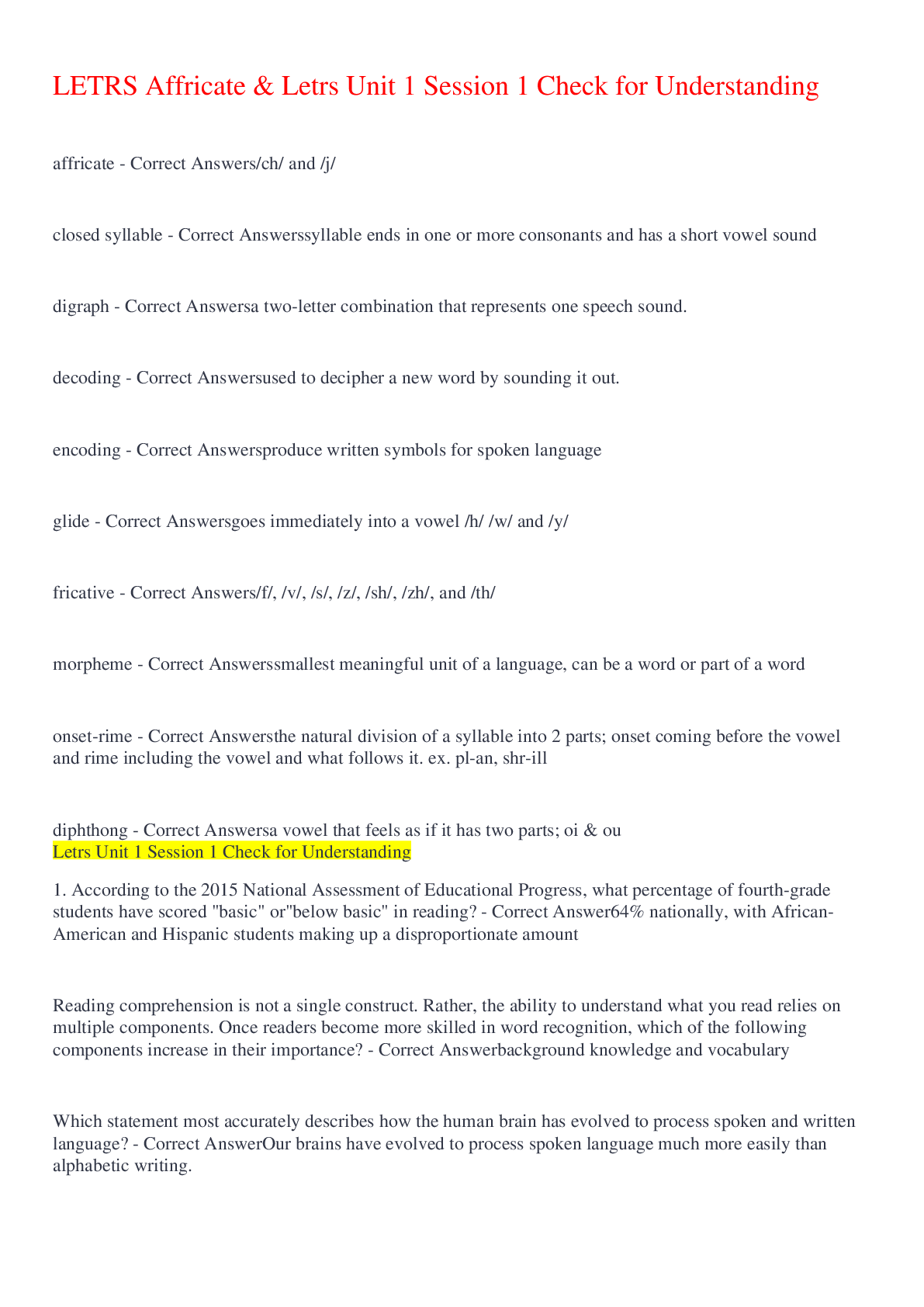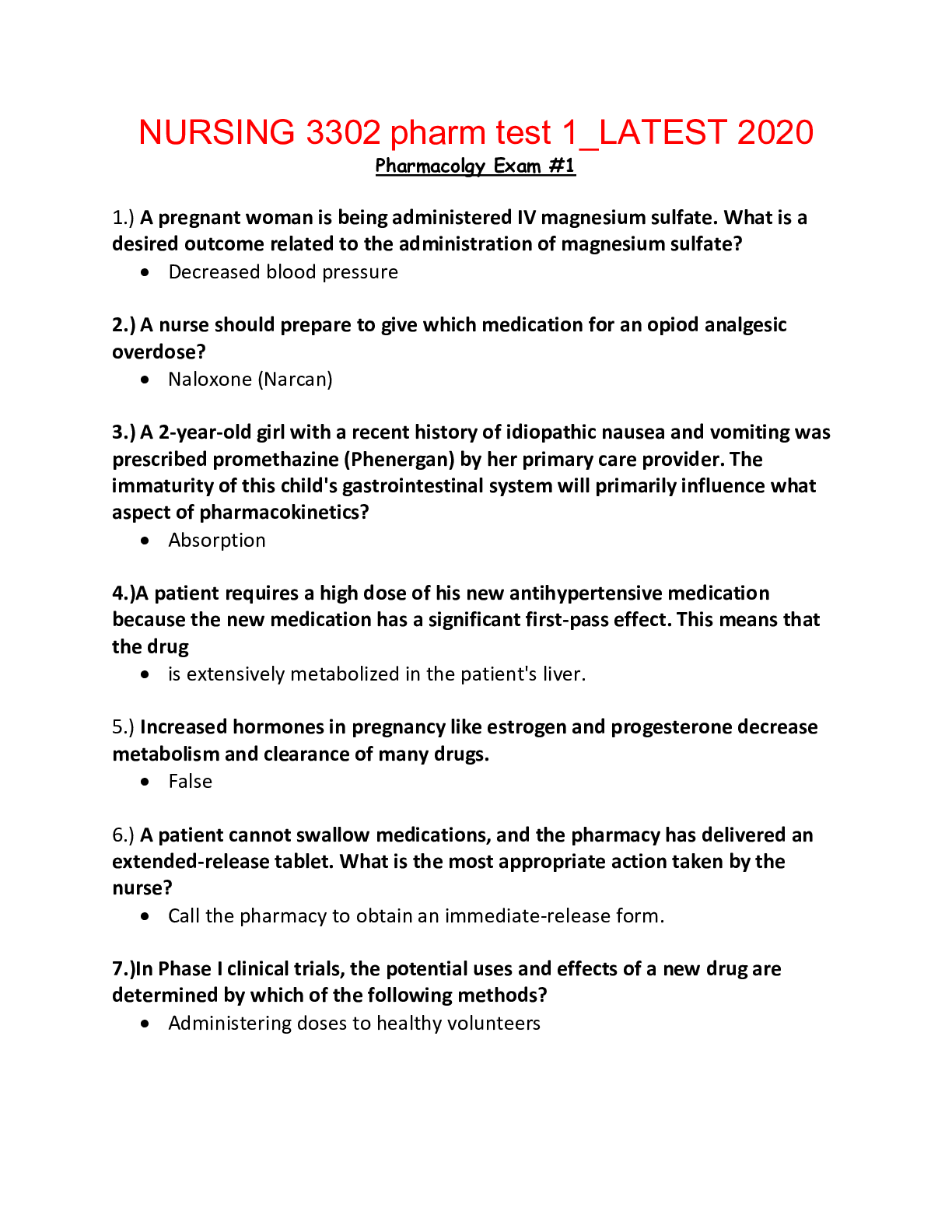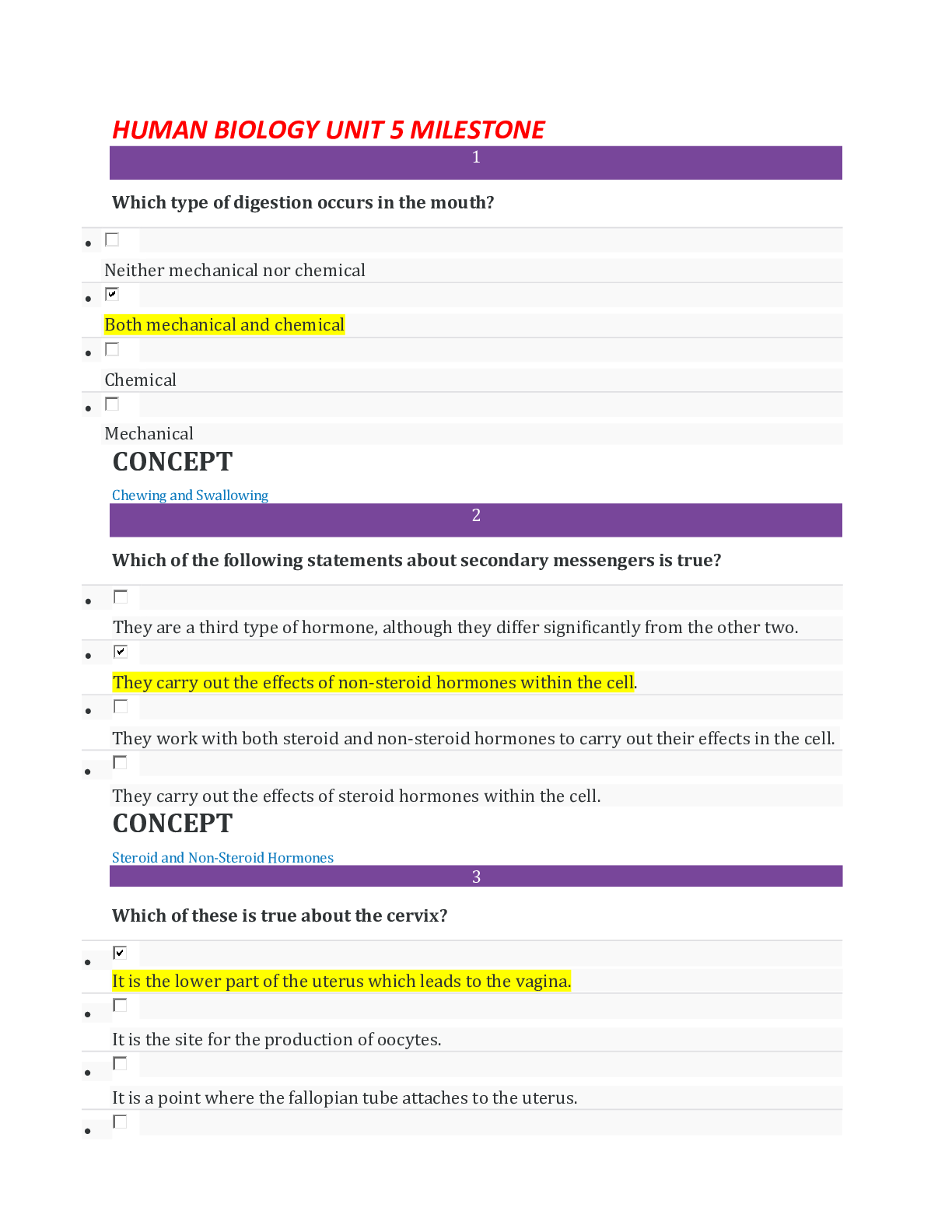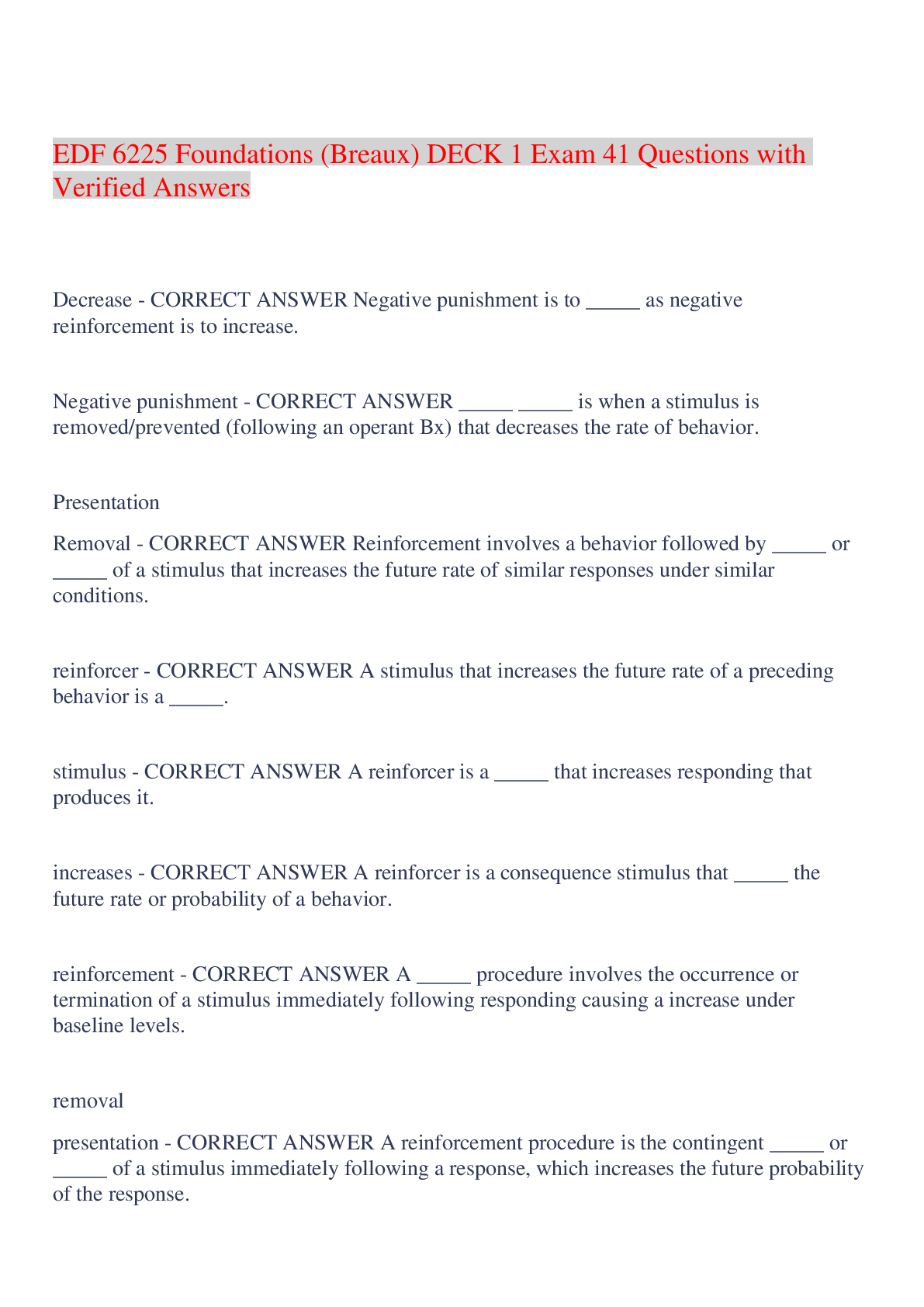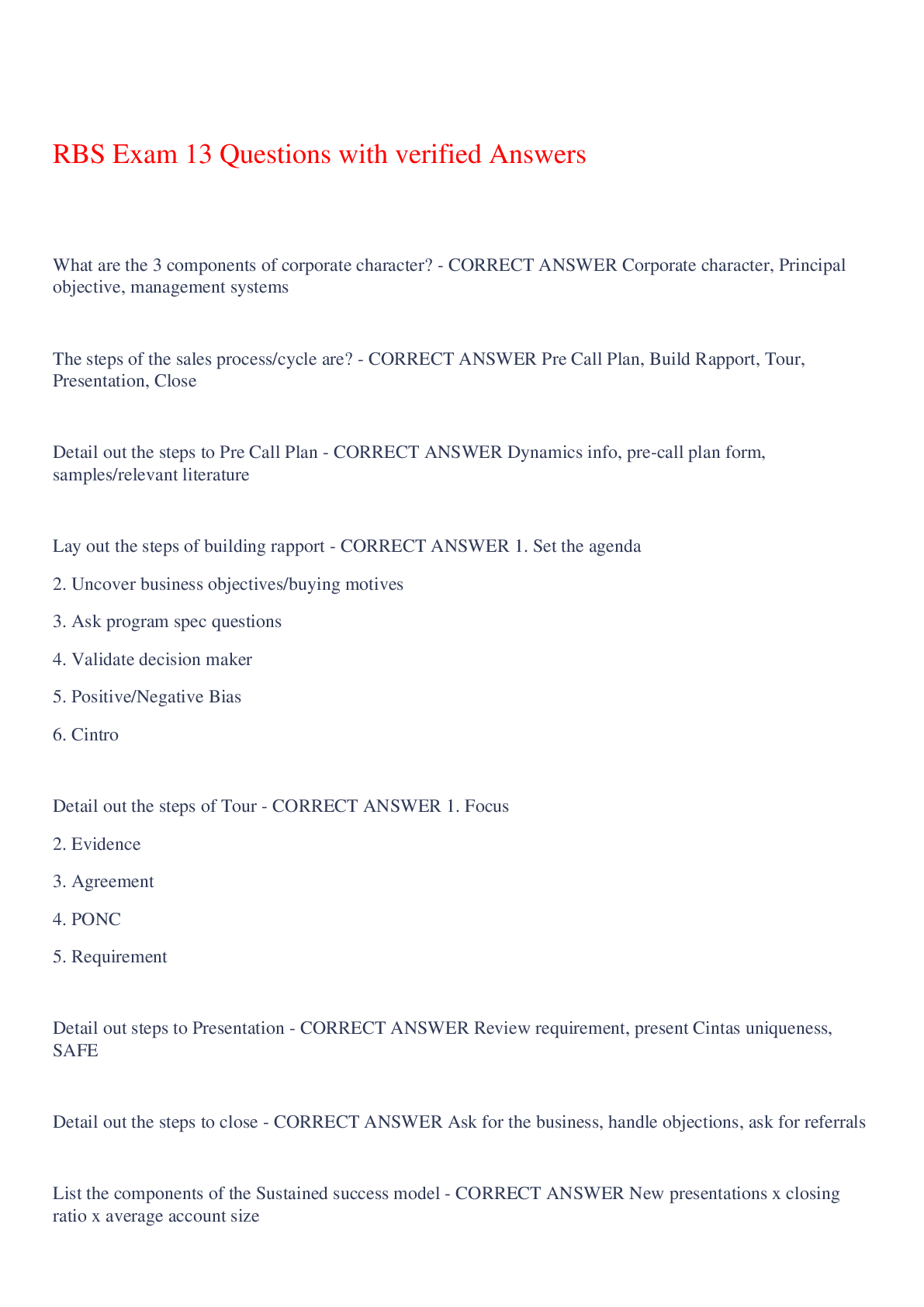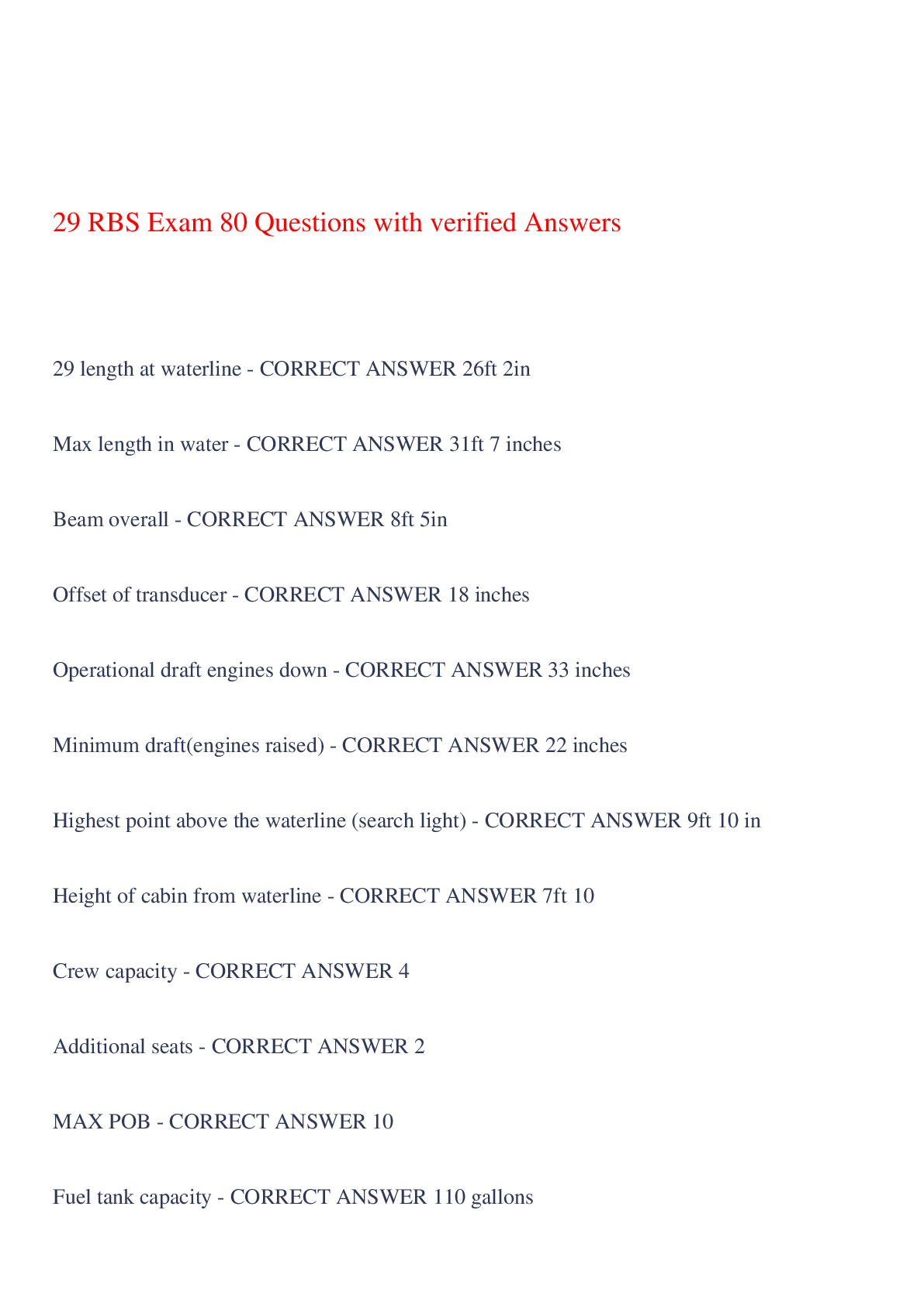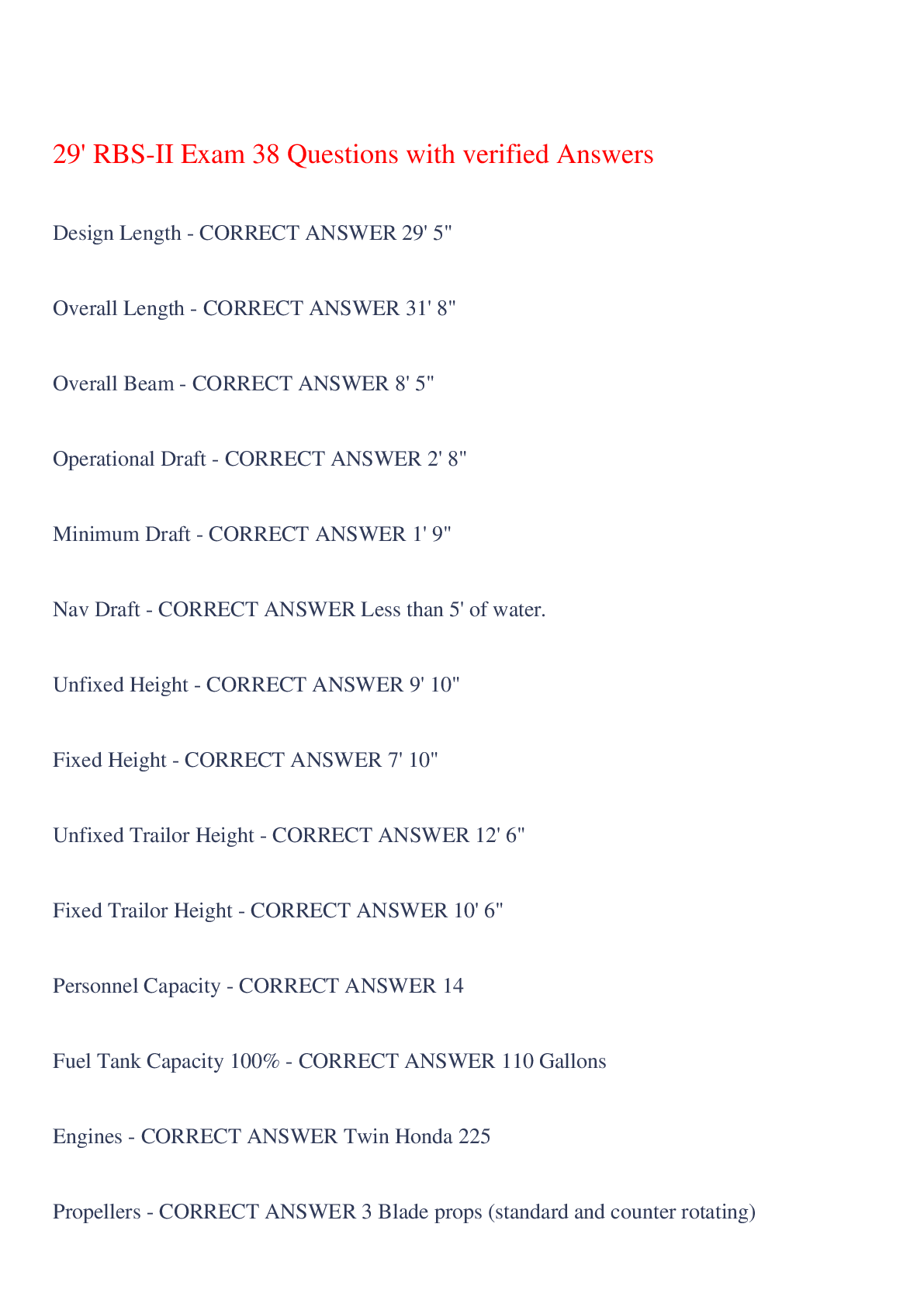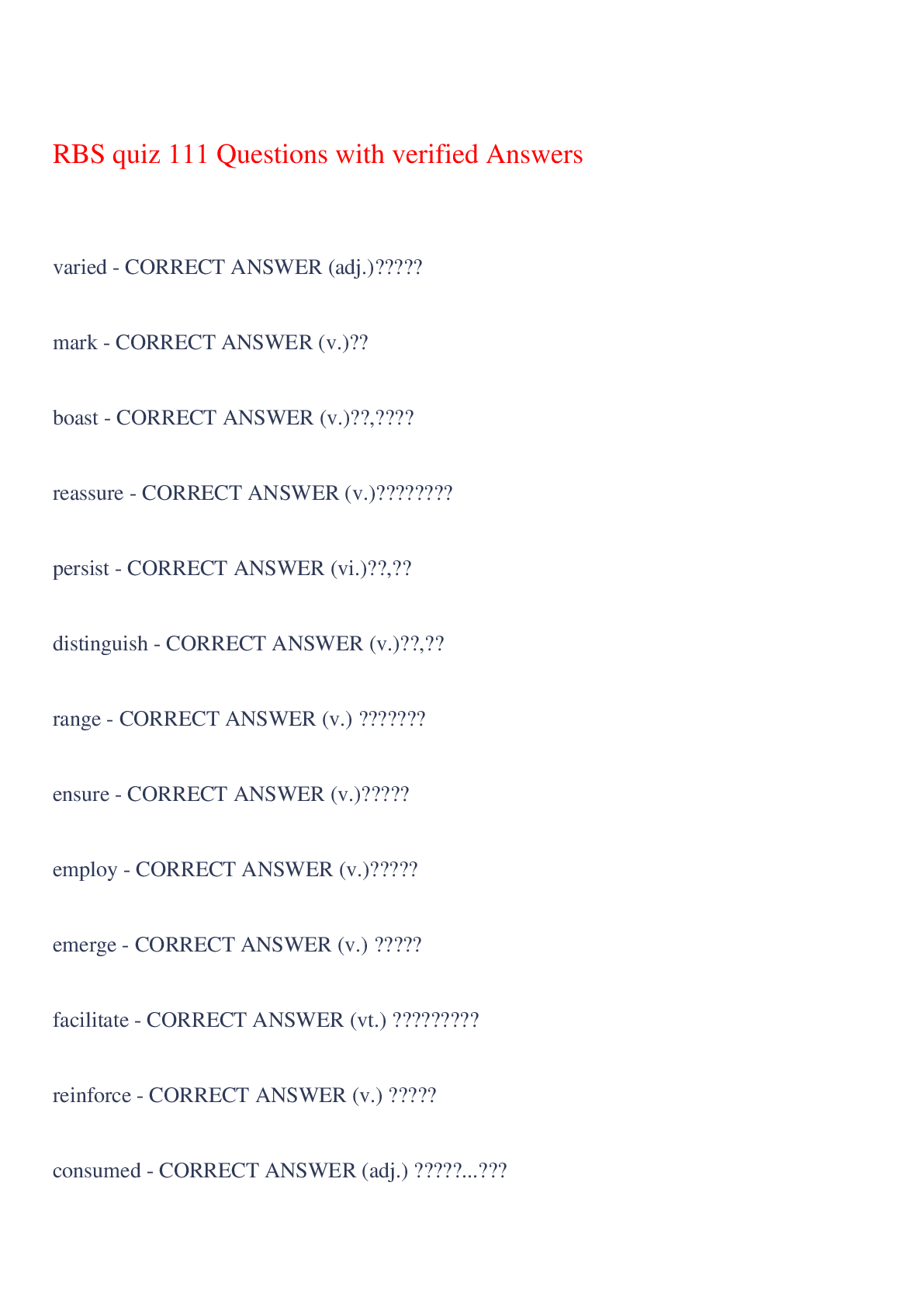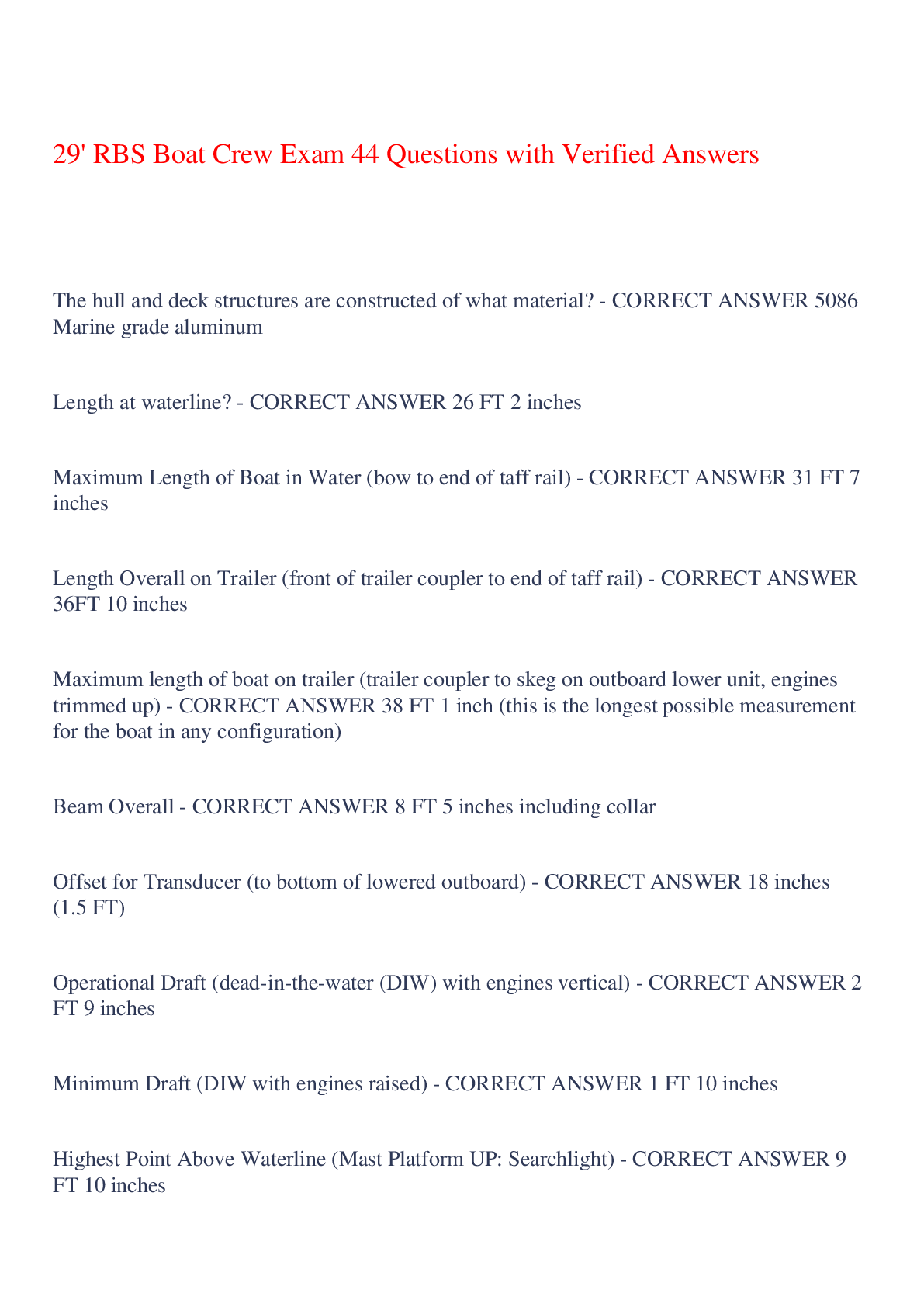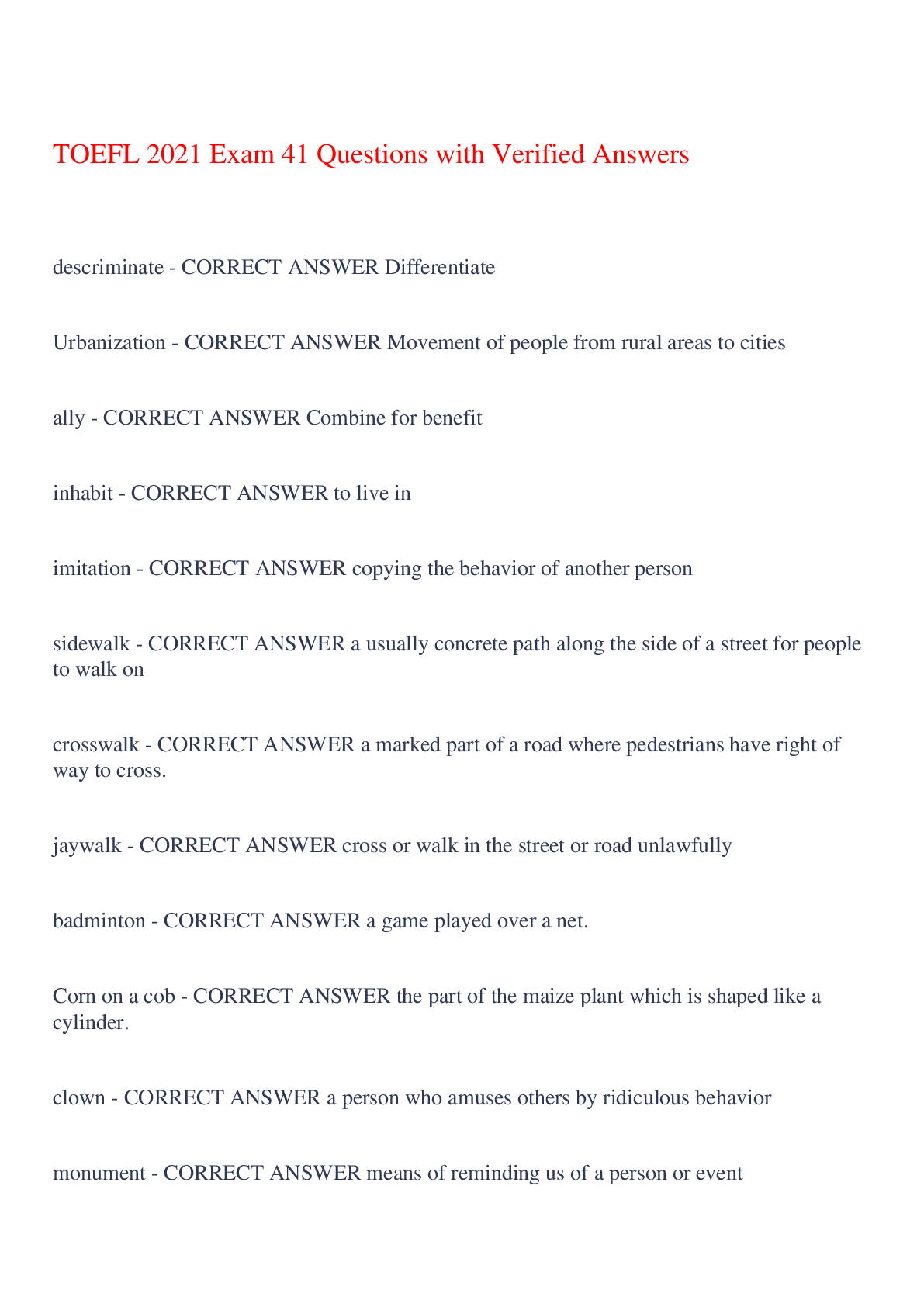Health Care > EXAM > NFPA 10 Exam 127 Questions with Verified Answers,100% CORRECT (All)
NFPA 10 Exam 127 Questions with Verified Answers,100% CORRECT
Document Content and Description Below
NFPA 10 Exam 127 Questions with Verified Answers NFPA 10 - CORRECT ANSWER Standard for Portable Fire Extinguishers NFPA 17 - CORRECT ANSWER Standard for Dry Chemical Extinguishing Systems NFP... A 17a - CORRECT ANSWER Standard for Wet Chemical Extinguishing Systems Portable fire extinguishers - CORRECT ANSWER The first line of defense to cope with fires of limited size Authority Having Jurisdiction (AHJ) - CORRECT ANSWER An organization, office, or individual responsible for enforcing the requirements of a code or standard, or for approving equipment, materials, an installation, or a procedure. Approved - CORRECT ANSWER Acceptable to the authority having jurisdiction. ANSI - CORRECT ANSWER American National Standards Institute carbon dioxide - CORRECT ANSWER A colorless, odorless, electrically non-conductive gas that is suitable for extinguishing class B and C fires. Dry Chemical - CORRECT ANSWER A powder composed of very small particles, usually sodium bicarbonate-,potassium bicarbonate-, or ammonium phosphate based with added particulate material supplemented by special treatment to provide resistance to packing, resistance to moisture absorption (caking), and the proper flow capabilities Wet Chemical - CORRECT ANSWER Normally an aqueous solution of organic or inorganic salts or a combination thereof that forms an extinguishing agent High Pressure Cylinder - CORRECT ANSWER Cylinders or cartridges containing nitrogen, compressed air, carbon dioxide, or other gases at a pressure higher than 500psi at 70°F. low pressure cylinder - CORRECT ANSWER Cylinders containing fire-extinguishing agent, nitrogen, compressed air, or other compressed gases at a service pressure of less than 500psi at 70°F. Fire extinguisher inspection - CORRECT ANSWER Quick check that the fire extinguisher is in it's designated place, that it has not been actuated or tampered with, and that there is no obvious physical damage or condition Tom prevent its operation. Fire extinguisher maintenance - CORRECT ANSWER A thorough examination of the fire extinguisher that is intended to give maximum assurance that a fire extinguisher will operate effectively and safely and to determine if physical damage or condition will prevent its operation , if any repair or replacement is necessary, and if hydrostatic testing or internal maintenance is required. Shall - CORRECT ANSWER Indicates a mandatory requirement. Should - CORRECT ANSWER Indicates a recommendation or that which is advised but not required. Extinguishers manufactured after this date must include the identification of the listing and labeling organization, the fire test standard, and the performance standard that the fire extinguisher meets or exceeds. - CORRECT ANSWER January 1st, 1986 Class A fire - CORRECT ANSWER Ordinary combustibles Class B fires - CORRECT ANSWER Flammable Liquids Class C fires - CORRECT ANSWER Contain an energized electrical component Class D fires - CORRECT ANSWER Contain combustible metals Class K fires - CORRECT ANSWER Fires in cooking appliances that involve combustible cooking media (vegetable or animal oils and fats). Class K fire extinguishers manufactured after this date shall not be fitted with "extended wand-type" discharge devices - CORRECT ANSWER January 1st, 2001 Only extinguishers of this type shall be installed in areas containing oxidizers (such as pool chemicals) - CORRECT ANSWER Water-type Where shall fire extinguishers be located? - CORRECT ANSWER In a conspicuous location near the path of egress Fire extinguishers having a gross weight not exceeding ______ shall be installed so that the top of the fire extinguisher is not more than _____ from the floor. - CORRECT ANSWER 40 lb, 5 ft Fire extinguishers having a gross weight greater than ______ shall be installed so that the top of the fire extinguisher is not more than _____ from the floor. - CORRECT ANSWER 40 lbs, 3.5ft In no case shall the clearance between the bottom of the fire extinguisher and the floor be less than _____. - CORRECT ANSWER 4 in The minimum rated single extinguisher for a light hazard occupancy for class A hazards is: - CORRECT ANSWER 2A The minimum rated single extinguisher for a normal hazard occupancy for class A hazards is: - CORRECT ANSWER 2A The minimum rated single extinguisher for an extra hazard occupancy for class A hazards is: - CORRECT ANSWER 4A A class A fire extinguisher protecting a light hazard occupancy will cover ______ per unit of A. - CORRECT ANSWER 3000sqft A class A fire extinguisher protecting a normal hazard occupancy will cover ______ per unit of A. - CORRECT ANSWER 1500sqft A class A fire extinguisher protecting an extra hazard occupancy will cover ______ per unit of A. - CORRECT ANSWER 1000sqft Fire extinguishers protecting a class D hazard shall not be located further away than - CORRECT ANSWER 75ft Fire extinguishers protecting a class D hazard shall not be located further away than - CORRECT ANSWER 75ft Fire extinguishers must be inspected at least every ______ - CORRECT ANSWER 31 days Fire extinguishers must be inspected at least every ______ - CORRECT ANSWER 31 days UL 1093 - CORRECT ANSWER Standard for Halogenated Agent Fire Extinguishers UL 1803 - CORRECT ANSWER Standard for Factory Follow-Up on Third Party Certified Portable Fire Extinguishers UL 8 - CORRECT ANSWER Water Based Agent Fire Extinguishers UL 154 - CORRECT ANSWER Standard for Carbon Dioxide Fire Extinguishers UL 299 - CORRECT ANSWER Standard for Dry Chemical Fire Extinguishers UL 626 - CORRECT ANSWER Standard for Water Fire Extinguishers UL 711 - CORRECT ANSWER Standard for Rating and Fire Testing of Fire Extinguishers UL 2129 - CORRECT ANSWER Standard for Halocarbon Clean Agent Fire Extinguishers Light hazard minimum B rating for 30ft distance - CORRECT ANSWER 5 B Light hazard minimum B rating for 50ft distance - CORRECT ANSWER 10 B Normal hazard minimum B rating for 30ft distance - CORRECT ANSWER 10 B Normal hazard minimum B rating for 50ft distance - CORRECT ANSWER 20 B Extra hazard minimum B rating for 50ft distance - CORRECT ANSWER 80 B Extra hazard minimum B rating for 30ft distance - CORRECT ANSWER 40 B 2-A Extinguisher Equivalent - CORRECT ANSWER Two 1-A water-types Maximum floor area coverage for any A rated extinguisher - CORRECT ANSWER 11,250sqft For Flammable Liquids of Appreciable Depth, how many units of B are needed per sqft of surface area? - CORRECT ANSWER 2 units, except AFFF and FFFP, then 1 unit. Internal exam interval for stored-pressure loaded stream and antifreeze - CORRECT ANSWER 1 year 4-A Extinguisher Equivalent - CORRECT ANSWER Two 2.5gal water-types Internal exam interval for pump tank water and pump tank, calcium chloride based - CORRECT ANSWER 1 year Internal exam interval for dry chemical, cartridge- and cylinder-operated, with mild steel shells - CORRECT ANSWER 1 year Internal exam interval for dry powder, cartridge- and cylinder-operated, with mild steel shells - CORRECT ANSWER 1 year Internal exam interval for stored-pressure water - CORRECT ANSWER 5 years Internal exam interval for AFFF and FFFP - CORRECT ANSWER 3 years Internal exam interval for wetting agent - CORRECT ANSWER 1 year Internal exam interval for stored-pressure dry chemical, with stainless steel shells - CORRECT ANSWER 5 years Internal exam interval for carbon dioxide - CORRECT ANSWER 5 years Internal exam interval for wet chemical - CORRECT ANSWER 5 years Internal exam interval for dry chemical stored-pressure, with mild steel shells, brazed brass shells, and aluminum shells - CORRECT ANSWER 6 years Internal exam interval for halogenated agents - CORRECT ANSWER 6 years Internal exam interval for dry powder, stored-pressure, with mild steel shells - CORRECT ANSWER 6 years Hydrostatic testing interval for stored-pressure water, water mist, loaded-stream, and/or antifreeze - CORRECT ANSWER 5 years Hydrostatic testing interval for wetting agent - CORRECT ANSWER 5 years Hydrostatic testing interval for AFFF and FFFP - CORRECT ANSWER 5 years Hydrostatic testing interval for dry chemical with stainless steel shells - CORRECT ANSWER 5 years Hydrostatic testing interval for carbon dioxide - CORRECT ANSWER 5 years Hydrostatic testing interval for wet chemical - CORRECT ANSWER 5 years Hydrostatic testing interval for dry chemical, stored-pressure, with mild steel shells, brazed brass shells, or aluminum shells - CORRECT ANSWER 12 years Hydrostatic testing interval for dry chemical, cartridge- or cylinder-operated, with mild steel shells - CORRECT ANSWER 12 years Hydrostatic testing interval for halogenated agents - CORRECT ANSWER 12 years Hydrostatic testing interval for dry powder, stored-pressure, cartridge- or cylinder-operated, with mild steel shells - CORRECT ANSWER 12 years Hydrostatic testing pressure gauges must be accurate within +/-_____ of the full range of the gauge - CORRECT ANSWER 0.5% Hydrostatic gauges shall be capable of indicating ____ to _____ of the test pressure - CORRECT ANSWER 90%, 110% Hydrostatic gauge test pressures shall be capable of being read to within ____ of the test pressure. - CORRECT ANSWER 1% Hydrostatic testing pressure gauges shall be calibrated at least _____ - CORRECT ANSWER Semiannually Master gauges or dead weight testers shall be calibrated at least _____ - CORRECT ANSWER Annually A hydrostatic test pump shall be capable of producing not less than _____ of the test pressure - CORRECT ANSWER 150% Temperatures used for drying shall not exceed _____ - CORRECT ANSWER 150°F The pressure in a hydrostatic test of a cylinder shall be maintained for a minimum of - CORRECT ANSWER 30 seconds The pressure in a hydrostatic test of a hose assembly shall be applied at a rate of rise such that the test pressure is reached in - CORRECT ANSWER 1 minute The pressure in a hydrostatic test of a hose assembly shall be maintained for a minimum of - CORRECT ANSWER 1 minute Test pressure for stored pressure types - CORRECT ANSWER As labeled, or where not specified, to factory test pressure, not to exceed 3x service pressure. Test pressure for cartridge operated types - CORRECT ANSWER At original factory pressure as shown on nameplate or shell Test pressure for DOT 3A, 3AA, or 3AL cylinders - CORRECT ANSWER 5/3 service pressure Test pressure for ICC3 cylinders - CORRECT ANSWER 3000 psi Test pressure of carbon dioxide hose assembly - CORRECT ANSWER 1250 psi Test pressure for low-pressure accessory hose on wheeled extinguisher - CORRECT ANSWER 300 psi Test pressure for dry chemical, dry powder, water, foam, and halogenated agent hose assemblies - CORRECT ANSWER 300 psi, or service pressure, whichever is higher Test pressure for high-pressure accessory hose on wheeled extinguisher - CORRECT ANSWER 3000 psi The record of a hydrostatic test shall be maintained by the organization that performed the test until either - CORRECT ANSWER The expiration of the test period or until the cylinder is again tested Compressed air used to recharge fire extinguishers shall have a maximum dew point of - CORRECT ANSWER -60°F Nitrogen used to recharge fire extinguishers shall have a maximum dew point of - CORRECT ANSWER -60°F Argon used to recharge fire extinguishers shall have a maximum dew point of - CORRECT ANSWER -65°F A regulated source of pressure, set no more than _____ above the operating pressure, shall be used to pressurize fire extinguishers. - CORRECT ANSWER 25 psi The gauge used to set the regulated source of pressure shall be calibrated at least - CORRECT ANSWER Annually The vapor phase of carbon dioxide shall not be less than _____ carbon dioxide - CORRECT ANSWER 99.5% The water content of carbon dioxide shall not be more than _____ by weight at _____ dew point - CORRECT ANSWER 60ppm, -52°F Oil content of carbon dioxide shall not be more than _____ by weight - CORRECT ANSWER 10ppm The agent in pump tank water and pump in tank calcium chloride-based antifreeze types shall be replaced - CORRECT ANSWER Annually The agent in pump tank water and pump in stored pressure wetting agent types shall be replaced - CORRECT ANSWER Annually The agent in AFFF and FFFP types shall be replaced - CORRECT ANSWER Every 3 years A carbon dioxide hose assembly electrical conductivity test shall be conducted - CORRECT ANSWER Annually Millimeter - CORRECT ANSWER 1 in. = 25.4 mm NFPA 32 - CORRECT ANSWER Standard for dry cleaning plants 2007 high pressure cylinders - CORRECT ANSWER Cylinders containing nitrogen, compressed air, carbon dioxide or other gases at a pressure HIGHER then 500 psi 70 degrees F. Low-Pressure cylinders - CORRECT ANSWER Cylinders filled with gas 500 psi or LOWER @ 70 degrees F. Extinguisher service pressure - CORRECT ANSWER Normal operating pressure as indicated on the nameplate or cylinder of a fire extinguisher. Factory test pressure - CORRECT ANSWER Pressure shown on the nameplate at which a shell was tested at time of manufacture. Wetting agent - CORRECT ANSWER When added to water, reduces surface tension and increases its ability to penetrate and spread. Dry chem. extinguishers manufactured prior to _________ seal be removed from service at next 6 year maintenance interval or next hydro test (unless wheeled-type dry chem.) - CORRECT ANSWER October 1984 Wheeled fire extinguishers shall be considered when: - CORRECT ANSWER 1) High hazard areas 2) Limited personal available, extinguisher should have: -High agent flow rate -Increased agent stream range -Increased agent capacity Low Hazard Occupancy Rating - CORRECT ANSWER -Levels of A and B combustibles are low. -Normal levels of A or less then 1 gal. of class B Ordinary (moderate) Hazard Occupancy Rating - CORRECT ANSWER -Moderate levels of A and B combustibles -Moderate levels of A or 1-5 gal of B Extra (high) hazard Occupancy rating - CORRECT ANSWER - High A/B combustibles - More then 5 gal of B in any room Travel distance for portable fire extinguishers shall not exceed.... - CORRECT ANSWER 50 ft. In class D hazards, extinguisher or extinguisher agent shall be located no more then ________ away from class D hazard. - CORRECT ANSWER 75 ft. In class K fire extinguishers, travel distance to extinguisher shall not exceed ______ from hazard. - CORRECT ANSWER 30 ft. Internal inspection - CORRECT ANSWER 6 years Minimum size label for carbon dioxide hose test pass? - CORRECT ANSWER 0.5 in. x 3 in. [Show More]
Last updated: 1 year ago
Preview 1 out of 11 pages
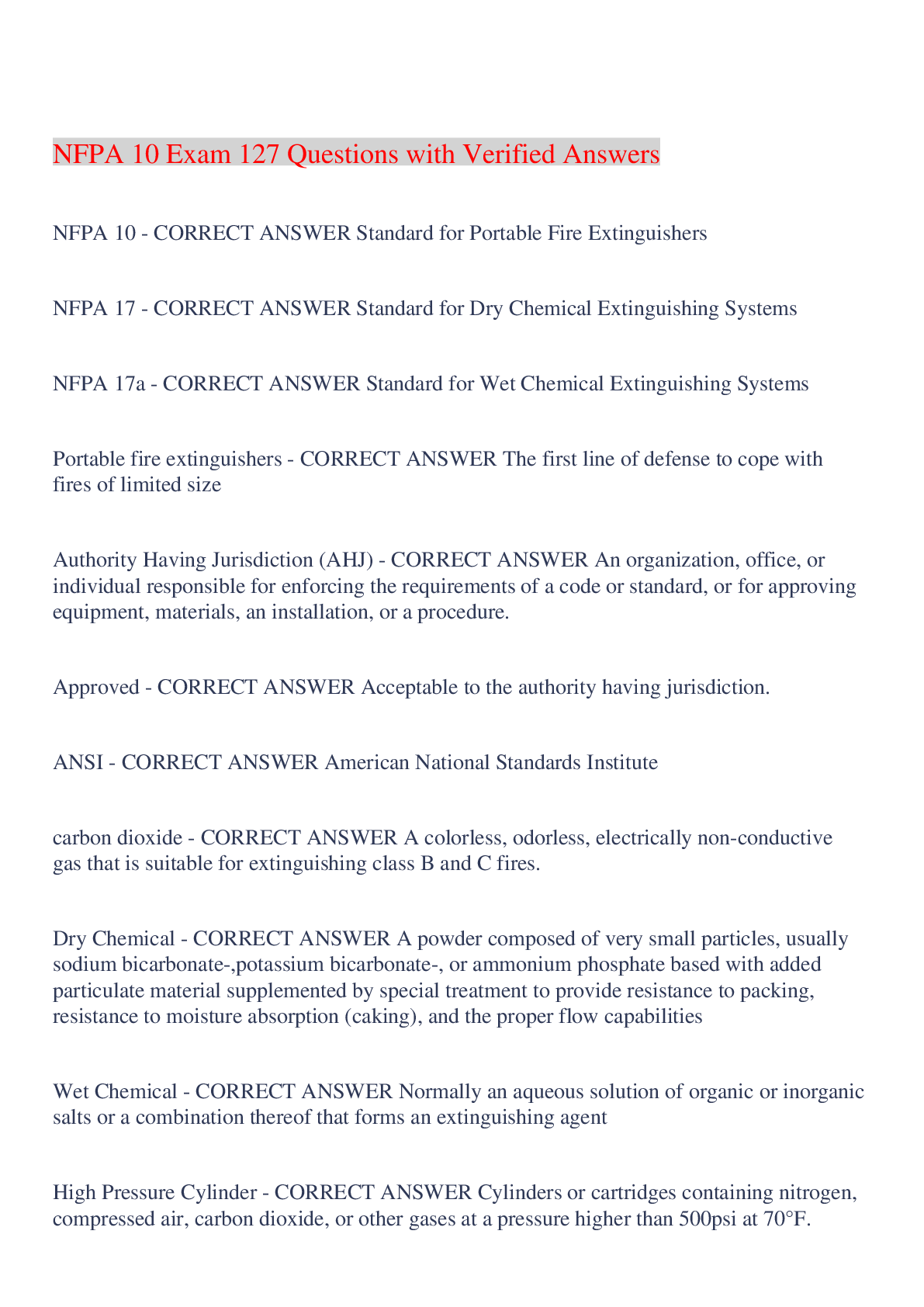
Buy this document to get the full access instantly
Instant Download Access after purchase
Buy NowInstant download
We Accept:

Reviews( 0 )
$8.50
Can't find what you want? Try our AI powered Search
Document information
Connected school, study & course
About the document
Uploaded On
Dec 10, 2023
Number of pages
11
Written in
Additional information
This document has been written for:
Uploaded
Dec 10, 2023
Downloads
0
Views
61



